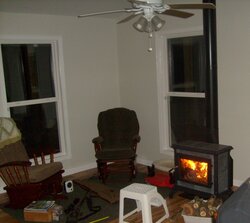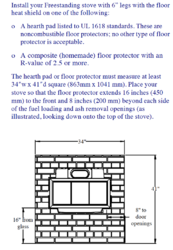I fired it up my Homestead stove at my newly built to be retirement home. Didn't get the results I'd hoped for. Both evenings I smoked the place pretty bad in starting the fire and then it burned out of control and cold again 6hrs later.
I expect the stormy wind plays a roll.
Using newspaper, small 1" and progressively larger to 3" oak to start. Smoke from the door until shut. All wood oak/hickory mix from trees downed 11months ago. Once it flames up, the control is pushed away toward back of stove to slow the air. An hour or 2 later with flames licking down, I slowly open door and east/west stack 2 3" dia and 1 5" dia hardwood (16 to 18in); smoke pours into the room at this time setting off the fire alarm. I haven't bought a thermometer yet (kinda disappointed at the lack of info when buying stove and set up), the room gets 78, my drywall is too hot too touch and the place cold 6hrs later. The stove emits an ominus roar. There's about 15' straight up triple wall 6" flue. It's needed most nights to back up the minimally performing reverse heat pump.
I read that some use foil around the air control to slow the overburn. Also I've ordered a stove backing to help with the drywall temps. I'll be out there again this last week of January. I don't need it during the 40+ degree days as the reverse heat pump takes over so firing up every evening may be routine.
Should I hold off using the stove running little 110volt heaters instead if windy? I seem to be doing a balancing act between getting easy to start wood and hot coals vs long burning wood and tamer coals. Any suggestions?

I expect the stormy wind plays a roll.
Using newspaper, small 1" and progressively larger to 3" oak to start. Smoke from the door until shut. All wood oak/hickory mix from trees downed 11months ago. Once it flames up, the control is pushed away toward back of stove to slow the air. An hour or 2 later with flames licking down, I slowly open door and east/west stack 2 3" dia and 1 5" dia hardwood (16 to 18in); smoke pours into the room at this time setting off the fire alarm. I haven't bought a thermometer yet (kinda disappointed at the lack of info when buying stove and set up), the room gets 78, my drywall is too hot too touch and the place cold 6hrs later. The stove emits an ominus roar. There's about 15' straight up triple wall 6" flue. It's needed most nights to back up the minimally performing reverse heat pump.
I read that some use foil around the air control to slow the overburn. Also I've ordered a stove backing to help with the drywall temps. I'll be out there again this last week of January. I don't need it during the 40+ degree days as the reverse heat pump takes over so firing up every evening may be routine.
Should I hold off using the stove running little 110volt heaters instead if windy? I seem to be doing a balancing act between getting easy to start wood and hot coals vs long burning wood and tamer coals. Any suggestions?

Last edited by a moderator:



